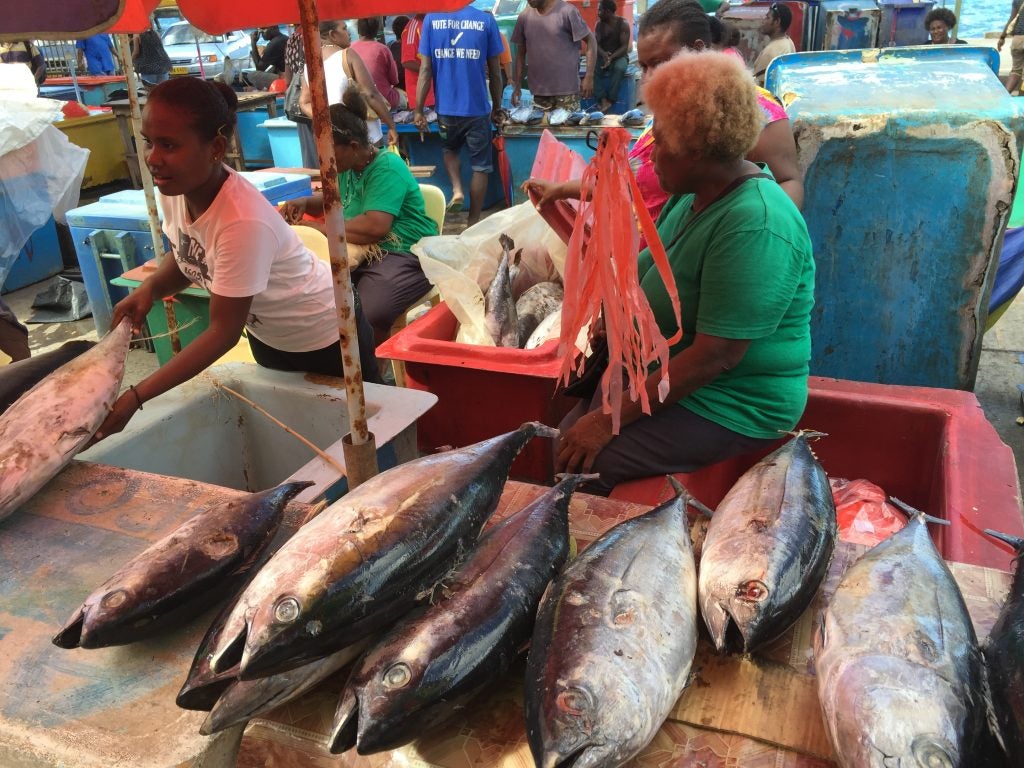 Tuna are one of the most iconic fish species, recognized all over the world for their importance ecologically, economically and culturally. As top predators, tuna—like sharks—are extremely important in structuring and regulating marine ecosystems, which in turn helps make the ocean more resilient to a changing climate and other stressors. Tuna are one of the most popular seafood products consumed around the world, but at present almost half (46%) of global tuna stocks are overfished or are slightly overfished[1].
Tuna are one of the most iconic fish species, recognized all over the world for their importance ecologically, economically and culturally. As top predators, tuna—like sharks—are extremely important in structuring and regulating marine ecosystems, which in turn helps make the ocean more resilient to a changing climate and other stressors. Tuna are one of the most popular seafood products consumed around the world, but at present almost half (46%) of global tuna stocks are overfished or are slightly overfished[1].
Given the importance of the species, and the challenges facing them, setting clear management goals and mechanisms to achieve these goals is necessary to ensure the long term viability of Pacific tuna fisheries.
EDF’s global initiative is to reform the world’s fisheries, and tip the global seafood system towards sustainability. A key part of this initiative involves active support for the sustainable management of Western and Central Pacific tuna fisheries. This region is a priority because over 50% of the world’s tuna catch comes from this part of the Pacific Ocean. Managing tuna fisheries in an economically and environmentally sustainable manner is challenging because tuna are highly migratory, moving across ocean basins and among the exclusive economic zones of numerous different countries. Successful management therefore requires close coordination among all of the countries fishing for tuna to ensure compatible measures are adopted and enforced.
During the first week of December, the 13th annual meeting of the Western and Central Pacific Fisheries Commission (WCPFC) will bring together representatives from over 25 countries to consider new management measures for several species of tuna, sharks, rays and sea birds. One of the key opportunities WCPFC members[2] will have during this meeting is the implementation of a science-based management approach, referred to as “harvest strategies” for each species of tuna. In the WCPFC, harvest strategies include a suite of tools such as reference points, which are guideposts that tell managers how the fishery is performing, and harvest controls rules that outline what actions to take if the fishery is over or under performing. In combination, these management tools create a framework for timely and responsive action to changing conditions in a fishery, thereby helping to improve fisheries management and support sustainability.
In order to successfully manage Pacific tuna fisheries, the WCPFC must take a number of steps to ensure the sustainability of the stock. These important objectives are outlined in the Work Plan for harvest strategies. They include: establishing clear management objectives for each of the tuna species; agreeing to timeframes to rebuild the bigeye tuna stock; adopting a target reference point for south Pacific albacore; and an initiation of a harvest control rule framework for skipjack and south Pacific albacore tuna.
Taking steps like these to establish a specific management framework can be challenging in a regional fishing management organization (RFMO), such as WCPFC, as decisions are made by consensus and some representatives fear harvest strategies will negatively impact the economic viability of their fisheries in the future. In reality, setting out clear management goals and mechanisms to achieve those goals is necessary to ensure the long-term viability of Pacific tuna fisheries. It is equally important to note that managing fisheries under a harvest strategies approach is not a new concept, harvest strategies have been under discussion in some form at WCPFC since 2007. In fact, many countries and other RFMOs already use reference points and harvest control rules to successfully manage various types of fisheries all over the world.
The implementation of harvest strategies at WCPFC is not just a priority for NGOs like EDF. This year over 20 different organizations, representing both environmental organizations and the fishing industry, jointly submitted a letter to the WCPFC calling for immediate action on this issue. Reference points and other associated management tools are important because they prevent subjective decisions regarding what amount of catch is sustainable and ensure timely, science-based management responses to changes in the status of a particular fishery. With the decline of bigeye tuna, the declining economic viability of the south Pacific albacore fleet, and concerns about the status of other important tuna species, the time is right for action.
EDF urges WCPFC members to support the full and timely implementation of the Work Plan for harvest strategies. The steps outlined in the Work plan are crucial for getting Pacific tuna fisheries on track so they can securely provide greater economic, ecological and social benefits to communities for generations to come.
[1] ISSF. 2016. ISSF Tuna Stock Status Update, 2016: Status of the world fisheries for tuna. ISSF Technical Report 2016-05B. International Seafood Sustainability Foundation, Washington, D.C., USA
[2] WCPFC members: Australia, China, Canada, Cook Islands, European Union, Federated States of Micronesia, Fiji, France, Indonesia, Japan, Kiribati, Republic of Korea, Republic of Marshall Islands, Nauru, New Zealand, Niue, Palau, Papua New Guinea, Philippines, Samoa, Solomon Islands, Chinese Taipei, Tonga, Tuvalu, United States of America, Vanuatu. WCPFC Participating territories: American Samoa, Commonwealth of the Northern Mariana Islands, French Polynesia, Guam, New Caledonia, Tokelau, Wallis and Futuna.









